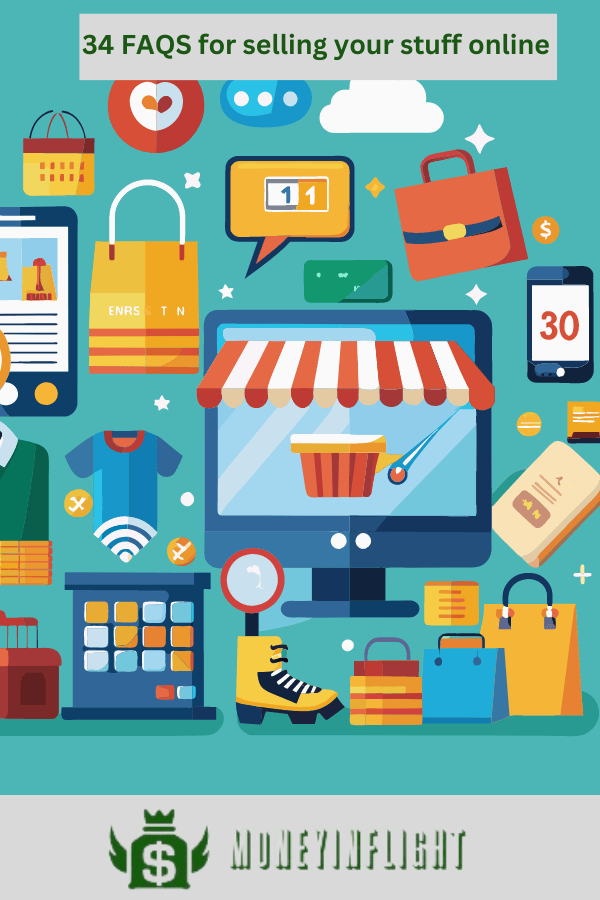DISCLOSURE: THIS POST MAY CONTAIN AFFILIATE LINKS, MEANING I GET A COMMISSION IF YOU DECIDE TO MAKE A PURCHASE THROUGH MY LINKS, AT NO COST TO YOU. PLEASE READ MY DISCLOSURE FOR MORE INFO.
You got some extra stuff taking up space?
Here are 34 FAQS to help you sell your stuff online.
What items can I sell online?
You can sell a wide variety of items online, including physical products, digital products, services, and even second-hand or used items. However, it’s important to research the specific platform you’re using to sell on to understand any restrictions on what you can sell.
What are the benefits of selling things online?
Selling things online can offer several benefits, such as reaching a larger audience, having lower overhead costs compared to brick-and-mortar stores, and being able to sell from anywhere with an internet connection.
What platforms can I use to sell things online?
There are several platforms you can use to sell things online, including marketplaces like Amazon and eBay, e-commerce platforms like Shopify and WooCommerce, and social media platforms like Facebook and Instagram.
What is the process for listing items online?
The process for listing items online can vary depending on the platform you’re using, but generally involves creating an account, taking photos of the item, writing a description, providing pricing and shipping information, and publishing the listing.
How can I price items effectively for online sales?
To price items effectively for online sales, research the market and see what similar items are priced at, factor in any overhead costs or fees, and consider offering promotions or bundles to entice buyers.
What is the shipping policy for online sales?
Shipping policies for online sales can vary depending on the platform and the seller’s preferences. Generally, the buyer will pay for shipping, and the seller will be responsible for packaging and shipping the item.
What is the return policy for online sales?
The return policy for online sales can vary depending on the platform and the seller’s preferences. It’s important to have a clear and fair return policy in place and to communicate it to buyers to avoid any misunderstandings or disputes.
How can I optimize my item descriptions for online sales?
To optimize your item descriptions for online sales, use clear and descriptive language, include relevant keywords, provide detailed measurements and specifications, and use high-quality photos that showcase the item.
What is a seller rating?
A seller rating is a score or ranking assigned to a seller based on factors like the number of sales, feedback from buyers, and the quality of customer service.
How can I improve my seller rating?
To improve your seller rating, it’s important to provide excellent customer service, be responsive to buyers’ questions and concerns, ship items promptly, and accurately describe the items you’re selling. Encourage buyers to leave feedback, respond politely and professionally to any negative feedback, and work to resolve any disputes quickly and fairly.
What are the fees associated with selling things online?
The fees associated with selling things online can vary depending on the platform you’re using. Generally, fees can be charged for things like listing items, selling items, or processing payments. It’s important to research the specific platform you’re using to understand the fees and how they may affect your profits.
How do I create a seller account on an online marketplace?
To create a seller account on an online marketplace, go to the website and look for a link or button that says “Sell” or “Sell on [platform name].” Follow the prompts to create an account, which will typically involve providing personal information, setting up payment and shipping information, and agreeing to the platform’s terms of service.
How do I handle payment for online sales?
Handling payment for online sales can vary depending on the platform you’re using. Typically, you’ll need to set up a payment processing account, such as with PayPal or Stripe, and link it to your seller account. When a buyer makes a purchase, the platform will typically hold the payment until the transaction is complete, then release the funds to your account.
How can I avoid scams when selling things online?
To avoid scams when selling things online, be cautious of any buyers who seem too eager to purchase an item without asking questions or negotiating the price. Be wary of requests to pay outside of the platform’s payment system, and carefully review any shipping and return policies. When in doubt, take the time to research the buyer and the platform’s policies.
What are the different types of online marketplaces?
There are several different types of online marketplaces, including general marketplaces like Amazon and eBay, specialized marketplaces like Etsy for handmade goods, peer-to-peer marketplaces like Craigslist, and B2B marketplaces like Alibaba.
What is an online auction?
An online auction is a type of marketplace where buyers can bid on items, with the item going to the highest bidder at the end of the auction period. Auction platforms typically involve a seller setting a starting price and a minimum bid increment, with buyers submitting increasingly higher bids until the auction ends.
How does bidding work in an online auction?
Bidding in an online auction typically works by buyers placing bids on items they’re interested in purchasing. The auction platform will typically have a bidding system that allows buyers to submit bids, with the highest bidder at the end of the auction period being the winner of the item. Some auction platforms may also have features like automatic bidding or bid increments to make the bidding process more efficient and fair.
What is a reserve price in an online auction?
A reserve price in an online auction is the minimum price that the seller will accept for the item being auctioned off. This price is usually kept private and is not visible to bidders during the auction. If the bidding does not reach the reserve price by the end of the auction, the seller is not obligated to sell the item to the highest bidder.
What is a buy-it-now price?
A buy-it-now price is a fixed price at which a seller is willing to sell an item in an online auction. This price is usually higher than the starting bid price, and allows buyers to purchase the item immediately without participating in the auction. A buy-it-now option can be a good strategy for sellers who want to ensure a quick sale.
What are the benefits of using an online auction?
Online auctions can be a great way to reach a large number of potential buyers and create a competitive bidding environment that can drive up prices. They can also be more convenient and efficient than traditional in-person auctions since buyers can participate from anywhere with an internet connection. Additionally, online auctions can be a good option for sellers who want to quickly monetize items that they no longer need or want.
What is an online storefront?
An online storefront is a digital storefront that allows businesses to showcase and sell products online. This can include features like product listings, shopping carts, payment processing, and customer reviews.
How do I set up an online storefront?
To set up an online storefront, you’ll need to choose an ecommerce platform or a website builder that includes ecommerce functionality. Some popular options include Shopify, WooCommerce, and Squarespace. Once you’ve chosen a platform, create a catalog of products, set prices and shipping options, and customize the design of your storefront.
What is a product catalog?
A product catalog is a listing of all the products that a business sells, typically arranged in a logical and meaningful way. Catalogs can include product descriptions, images, pricing information, and other details to help customers make informed purchasing decisions.
How do I create a product catalog for my online storefront?
To create a product catalog for your online storefront, you’ll need to compile a list of all the products you want to sell, along with relevant information like product descriptions, images, and pricing details. You can use an ecommerce platform or a website builder with ecommerce functionality to create and organize your catalog, and make it easily navigable for customers.
How do I manage inventory for online sales?
To manage inventory for online sales, you’ll need to keep track of your stock levels and ensure that you have enough products to meet customer demand. You can use an inventory management system or software to track your stock levels, set alerts for low inventory, and automate the ordering process with suppliers.
What is a product listing ad?
A product listing ad is a type of online ad that shows a product image, description, and pricing information. These ads can appear on search engines, social media platforms, or commerce websites, and allow businesses to promote their products to a wider audience.
How can I create a product listing ad?
To create a product listing ad, you’ll need to choose a platform to advertise on that supports this ad format, such as Google Ads or Facebook Ads. You’ll then need to create a campaign, select your target audience and budget, and input information about the product you want to advertise, such as the title, description, and image.
What is a sponsored product ad?
A sponsored product ad is a type of online ad that promotes individual product listings on ecommerce platforms like Amazon or eBay. These ads allow businesses to increase their visibility and reach a wider audience of potential buyers.
How can I create a sponsored product ad?
To create a sponsored product ad on an ecommerce platform, you’ll typically need to open a seller account, choose the product you want to promote, set a budget and choose your target audience, and launch the campaign. You can then monitor the performance of your ad campaign and adjust your budget or targeting as needed.
What are the benefits of paid advertising for online sales?
Paid advertising can provide several benefits for online sales, including increased visibility, increased traffic to your online storefront, and the ability to reach a wider audience of potential customers. Paid advertising can also be targeted to specific demographics or interests, allowing for more efficient use of advertising budgets.
How can I optimize my online sales listings for search engines?
To optimize your online sales listings for search engines, you’ll want to focus on including relevant keywords in your product titles, descriptions, and tags. Additionally, you should aim to write unique and informative descriptions that provide value to potential buyers. You can also optimize your product images by using descriptive file names and alt text tags.
How do I handle customer service for online sales?
To provide good customer service for online sales, you’ll want to be available and responsive to customer inquiries and concerns. This can include providing clear product descriptions, responding promptly to messages and emails, and offering easy return or exchange policies. You can use a customer service management system or software to help streamline your support operations.
What is a feedback rating?
A feedback rating is a metric used to assess a seller’s reputation and reliability in online marketplaces. It is typically based on customer reviews and ratings of the seller’s products or services.
How can I improve my feedback rating?
To improve your feedback rating, you’ll want to focus on providing excellent customer service and product quality. You can also make it easy for customers to provide feedback and encourage them to leave reviews after they make a purchase. Additionally, you can use feedback from customers to improve your products and services in the future.
What are some common mistakes to avoid when selling things online?
- Some common mistakes to avoid when selling things online include:
- Not defining clear and achievable goals for your online sales.
- Not performing proper market research to understand your target audience and competition.
- Not optimizing your product listings for search engines and customer needs.
- Providing subpar customer service, such as slow response times or difficult return policies.
- Not leveraging customer feedback to improve your products and services.

Personal finance geek and explorer of the web who loves to post in-depth blog posts about his findings.

